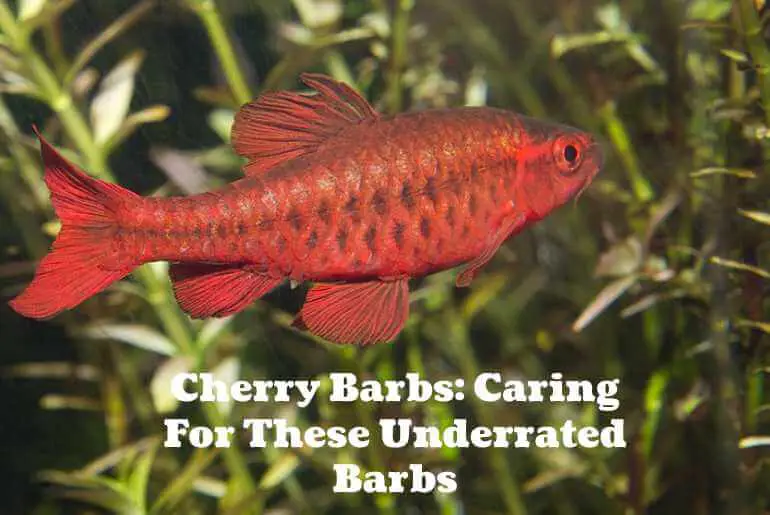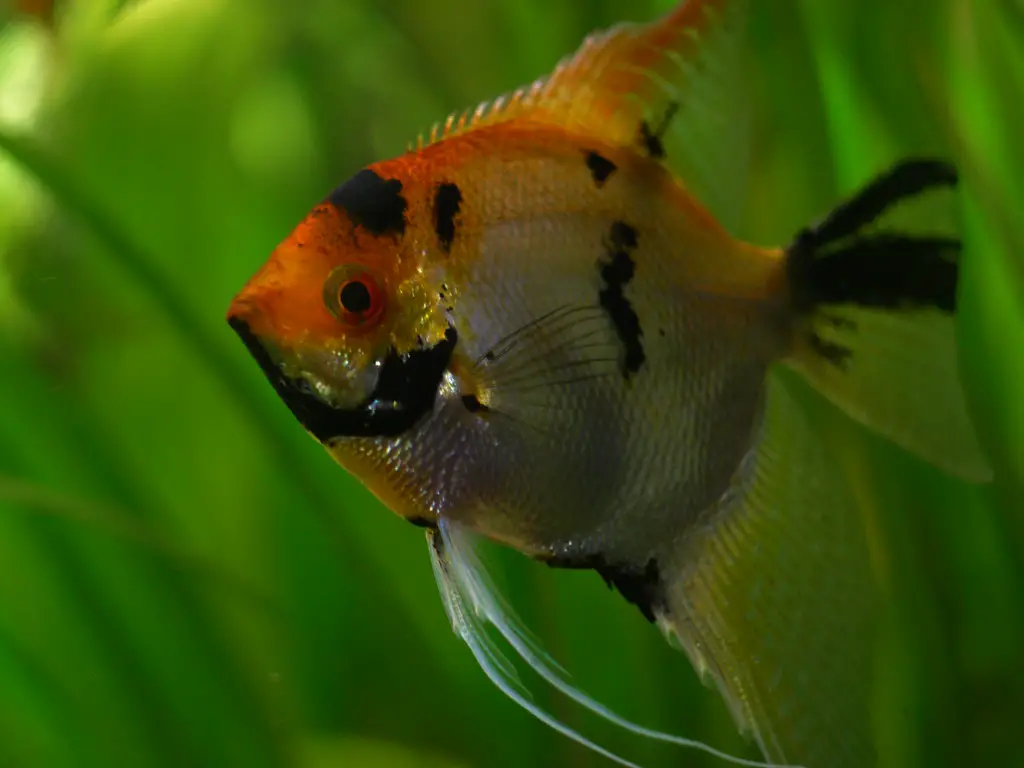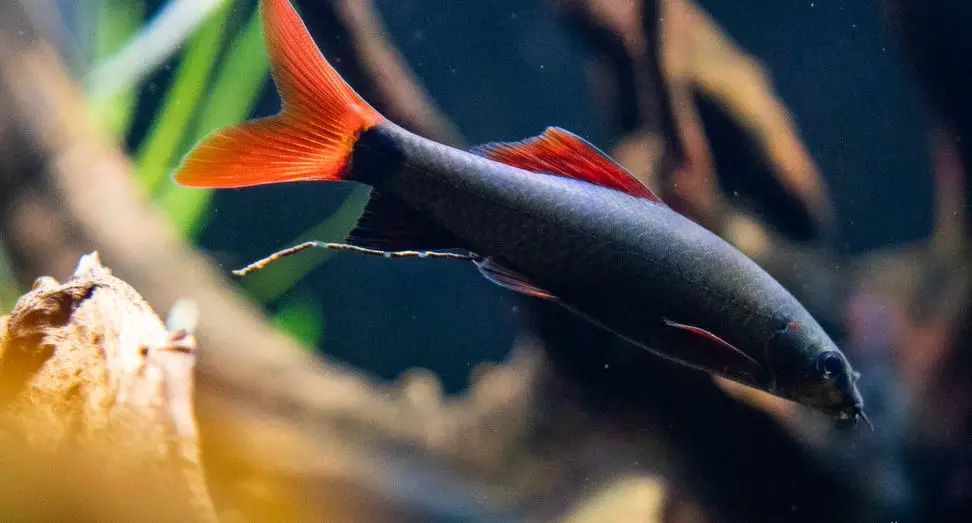Taking care of cherry barbs is considered an easy task. Whether you are looking to have these fish newly in your tank, or you want to learn reasonable ways to preserve them, you have come to the right article.
Cherry Barbs are another variety of popular species among aquarium pet owners. Although these fish have been listed as endangered species, they are still available widely in aquarium markets across the world. Rather than underrated, cherry barbs are adored and preferred by almost everyone because of their beautiful appearance and peaceful behavior.
Here, I have explained everything related to cherry barbs in the context of their habitat, breeding, caring, and so on.
Cherry Barbs Natural Habitat
Cherry Barbs belong to the Cyprinidae family, which is the largest fish family in the world with over 2000 species in it. They are freshwater fish, being originally native to Sri Lanka. And because they can easily adapt to other water conditions, cherry barbs are widely found in many parts of the world, as they have been transferred and bred in proper conditions.
I have written a bunch of articles on freshwater tanks. This is your checklist! Have a look at these too!
- Freshwater Aquarium Equipment Checklist
- Beginners Freshwater Fish Guide
- Beginners Guide To Installing Freshwater Sump Filter And Media To Add-In
- 30 Best Algae Eaters For Freshwater Aquarium
Are Cherry Barbs Rare?
However, cherry barbs have been categorized as “vulnerable” on the IUCN Red List. Their species are considered as endangered as their population has been gradually declining in the wild. There are many causes behind this situation, such as poaching activities, unsuitable water conditions, and the growing loss of their natural habitat.
Fortunately, their trade in the aquarium market is one of the main reasons why their population is still stable. Aquarium traders and fish pet owners have preserved these species by giving them adequate care and a suitable environment responsibly.
What Type Of Behavior Do Cherry Barbs Show In Aquarium?
Cherry barbs have a peaceful behavior in a community tank. Also, due to their schooling behavior, cherry barbs love to blend in and stay with a group in the water. This character makes them feel safe and even prevents them from shying and hiding from others.
Lifespan
Under proper caring, cherry barbs can live up to 5 to 7 years.
The Appearance of Cherry Barbs
They can grow fully up to 2 inches in length. Besides, due to their long and thin body structure, these fish can swim fast with other fishes in the tank.
Speaking of their appearance, cherry barbs have it in their name. They appear to be of bright, cherry red color. Usually, the males have brighter colors than the female cherry barbs. This is how you can easily distinguish between their genders.
Tank Setup And Habitat For Cherry Barbs
Managing the tank and water conditions for cherry barbs is easy. You have to make sure that their current living environment is as similar to their natural habitat in the wilds. This will make it suitable for them to survive and live well in the tank environment.
Tank Setup
The following things will help you set up the perfect tank for your Cherry Barb:
Tank Size
Considering their schooling behavior, you will require a decent sized tank for these fish. So, a tank size of at least 25 to 30 gallons is suitable for them. This size is necessary because your cherry barbs will have plenty of room to move around in a group, and also, they will have spaces to hide from others while spawning.
SeaClear 30 gal Show Acrylic Aquarium Combo Set, 36 by 12 by 16″, Clear is a perdect 30 gallon tank that comes in a combo set and is quite affordable and sturdy! SeaClear is a pretty famous brand when it comes to good aquariums.
Also check out The 8 Simple Step Process On How To Set Up a Fish Tank For Beginners for easy guide.
Plants
Your tank must be well planted as cherry barbs are familiar to such a type of habitat. Both floating plants and surface plants can be added to the tank, such as anacharis, java fern, hornwort, and water wisteria. Having plants allow these fish to play around, hide within, and make them look even brighter.
To find out more about the benefits of plants, check 9 Best Low Light Aquarium Plants | Benefits of Aquarium Plants.
| Image | Plants for tetra aquarium | Link |

|
Greenpro | Water Wisteria Green 3-Bundle Live Aquarium Plants Package Freshwater Fish Tank | |
 |
Hornwort | |
 |
Java Fern | |
 |
Anubias Petite | |
 |
Anacharis |
Lighting
Maintain a low lighting effect in the tank. Cherry barbs come from waters with much vegetation, which provides shades in the water. Therefore, make sure you have enough surface pants to allow shades in the tank too.
Ticoze LED Aquarium Light, Fish Tank Light Dimmable Full Spectrum Aquarium Light (Aquarium Cleaning Brush Included) would work best specially for cherry barbs since it is so easy to dim the lights!
Substrate
The tank floor is better when it is of any dark color. Cherry barbs love such an environment, plus they also appear shiny in such a dark background. For this, you can have a darker substrate, like dark sand or coarse gravel.
If you are looking for perfect dark colored substrate for your aquarium, I would suggest you to check Flourite Black Sand, 7 kg / 15.4 lbs.
Other Decorations
Besides, you can have other decorations on the tank floor, such as rocks, driftwood, and caves. But, do not make the area crowded because these fish also need plenty of space to swim around altogether.
Water Condition
Cherry Barbs are hardy fish, and they can also adapt to water fluctuations. But still, you need to maintain a proper water condition for these fish to avoid health issues.
You must avoid tap water in your aquarium tank. Because tap water in most places is treated with chlorine, it is not safe for these fish to survive in these waters. For this, you can place a water container to provide clean water and keep your fish safe.
Temperature Of The Tank Water
Speaking of water temperature, you must keep it between 73°F and 81°F. This temperature is perfect for cherry barbs to live in. Also, keep the water flow moderate in the tank. This will allow them to swim faster and easier.
Fluval E Electronic Heater is the best heater available in the market with 100, 200, and 300 watts which supports up to 100 gallons. It also sets the temperature from 68° F to 93° Fdegrees, and is completely automatic. You can adjust temperature as you want!
PH And Hardness Of The Tank Water
You need to maintain the aquarium water pH level between 6 to 8 and keep the water hardness between 5 to 19 DH. Cherry barbs are suitable for soft to moderately hard water.
Make sure that you do a regular test of the tank water for which you can use API FRESHWATER MASTER TEST KIT 800-Test Freshwater Aquarium Water Master Test.
Maintain the temperature and adjust the conditions as stated above. You must ensure that the water condition is consistent, or else there can be certain health concerns arising in your fish.
Tank Mates And Companions
Cherry Barbs are peace loving fish. Thus, they should be allowed to stay with similar characters. Such tank mates can be fishes like rainbow sharks, dwarf gourami, molly fish, neon tetra, glass catfish, etc.
Besides, there are certain tank mates other than those fish that are compatible with cherry barbs. Due to their peaceful nature, cherry barbs can have other invertebrates as their tank mates too. Such creatures include mystery snails, cherry shrimps, and ghost shrimps.
In a community tank, cherry barbs behave peacefully with other fish. During their first days in the tank, they will hide and show less activeness. As the days pass by, they will become equally active and play around with others.
On the other hand, you must not allow cherry barbs to interact with aggressive fishes. These fishes can harass and even attack cherry barbs, causing them to hide and become stressed. So you must avoid having an aggressive companion or tank mate for cherry barbs.
Feeding The Cherry Barbs
Cherry Barbs are omnivorous fish. In their wild habitat, they are very much flexible while eating. They can eat anything such as algae, planktons, tiny insects, worms, etc.
This similar habit can go on in their tank habitat too. You must feed them proper food with enough protein and minerals in it. This will keep them strong and vibrant in color as well.
What To Feed Cherry Barbs?
You can feed them both frozen and live food like:
- brine shrimp: Omega One Freeze Dried Brine Shrimp, 1.28 oz
- bloodworms: SAN FRANCISCO BAY Brand Freeze Dried Bloodworms 1.75oz
- daphnia: 1000+ Live Daphnia Magna
You can also feed them with high-quality flake food containing essential nutrients in it.
How Much To Feed Cherry Barbs?
It is enough to feed Cherry barbs two to three times a day. Make sure that you do not overfeed or underfeed them to avoid health issues. Keep a close watch on how much they eat. If they have not finished all food given to them before, then provide them a bit less amount in the next turn.
Grab more information on Fish Food 101: A Beginner’s Guide On How To Feed Aquarium Fish.
How To Breed Cherry Barbs
Cherry Barbs tend to breed naturally. That is why initiating the breeding of cherry barbs is easy. All you need is one or two separate tanks for these fish to breed and store eggs. And consider the process below to enable their successful breeding.
Setting Up Tank Conditions
The first step to breed these fish is to move the pair into a separate tank. The suitable tank condition for breeding can be set similar to their usual tank environment.
A tank size of 10 to 15 gallons is enough for the breeding aquarium. Make sure that this tank is well planted so that the fish is comfortable to lay their eggs. In their wild habitat, cherry barbs use plants to hide and protect their eggs. Thus, they will find it suitable if the place includes a lot of plants.
Spawning And Hatching Eggs
Cherry Barbs are also egg-scattering fish. A pair of cherry barb can lay about 200 to 300 eggs, scattered across the tank floor.
Since they lay a large number of eggs, you can use a spawning mop to collect and gather the eggs easily. Pssopp 60cm/100cm Mops Camouflage comes with 100 Strands plus Suction Cups Plant Decoration which is the perfect spawning mop for your aquarium! I liked it best personally.
Once the female is done laying eggs, you must move the male into the main tank. Because females would be less energetic after spawning, they must be kept separated from the males, as cherry barb males can become aggressive towards the female at this point.
Also, you must keep the parent fishes separate from the tank where their eggs are stored. This is because cherry barbs are known to eat their eggs when in captivity. So you must remove them to ensure a better survival rate of the fry.
Cherry Barbs Fry Care
After spawning, cherry barbs scatter the eggs and do not show care for their fry. Instead, they can eat the eggs and even the fry too. Thus, it is better to keep them separate from their eggs. So, it is better to set up a separate fry tank for your cherry barb.
Tank Water Conditions
In the fry tank, keep the tank’s condition as natural as possible. For this, the tank must be dimly lit, and maintain low water movement. The water temperature should be adequate at 80°F to 81°F.
Feeding The Fry
The eggs will hatch in a few days. The fry will spend 1 to 2 days absorbing nutrients from the egg’s yolk sac. Then, the fry starts swimming around in the tank. Begin feeding them with tiny food such as micro worms, crushed flakes, and vinegar eels. It will allow them to grow rapidly. In time, they will be grown enough to have proper food like brine shrimps.
Feed the fry about 3 times a day. And keep the water clean by changing ¼ part of water every 3 to 4 days. The fry will shelter among the water plants and can consume the plant matter in it.
Cleaning The Fry Tank
When the fry are free swimming around, you must remove the unhatched eggs from the tank bottom. If it is not removed in time, it can contaminate the water with fungus and affect the fry’s health. You can use an air pump pipe to remove them from the tank bottom.
In the course of 2 months, the little ones will grow to their adult size. At this point, you can put them back into the main tank.
Common Diseases In Cherry Barbs
Cherry Barbs are extremely hardy fish. They are very much resistant to diseases, as they are not easily infected by species-specific illness. But this does not mean that these fish are completely invulnerable to any diseases.
If you fail to maintain an adequate tank environment, then these fish can be prone to diseases too. If they lack sufficient diet and are living in an unfit tank condition, cherry barbs can easily fall sick. Here are some common diseases seen in cherry barbs:
Ich
Ich is a major freshwater fish disease. It usually occurs in your fish when their immune system is not working properly. This may come to be due to unsuitable water conditions in the tank.
The fish suffering from ich will have white spots appearing all over their body. You may notice a change in their behavior as the fish begins to scratch their body on the surface.
Gold-dust Disease
Gold-dust disease is caused by a parasite, and it is seen infecting cherry barbs most often. The parasite attaches itself to the fins and gills of the fish and forms a velvety layer on the fish skin.
Once infected, your fish will show symptoms like loss of appetite, hardness in breathing, and less energy. They are often seen rubbing their skin against hard surfaces.
Fin Rot
Fin rot is a bacterial disease seen in tank fish. It is especially caused due to poor condition and caring of the tank.
The fish suffering from fin rot will have unusual fins. Their fins appear to get rotten and then torn away as well.
Dropsy
Dropsy may be caused due to overfeeding your fish or a micro-organism infesting in their internal organs. If your fish has a bloated stomach, then there is a high probability that it is suffering from dropsy.
Apart from a bloated stomach, the fish is affected in other ways such as lethargy, staying and hiding at the tank bottom, and loss of appetite.
Protection And Care For Cherry Barbs
The best way to keep cherry barbs away from getting infected is by cleaning up their tank regularly. If their tank habitat is made safe by setting up proper temperature and hardness conditions, they will not be prone to any common fish diseases.
Make sure that you regularly checkup the tank conditions for them. If there are major fluctuations seen, then you must act quickly to turn the condition to normal. Also, keep a proper eye on your fish to check if they are behaving unusually.
Besides, cherry barbs must not be kept with aggressive species of fish. They can be easily harmed and attacked by such violent and large fish. You can keep them with other peaceful fish with who they will feel comfortable to hang around.
Plus, feed your fish routinely on daily basis. Remember, you should not feed them too much or too little. Just feed them with the perfect amount of food which is rich in proteins and nutrients.
Conclusion
Cherry Barbs make an amazing collection for the fish family. These peaceful fish are easy to care for beginners and experts in their aquarium. Thanks to the aquarium owners that their species are being preserved across the world. Like I have said before, maintaining a stable environment and giving them proper care can ensure their full survival.
Related articles:






